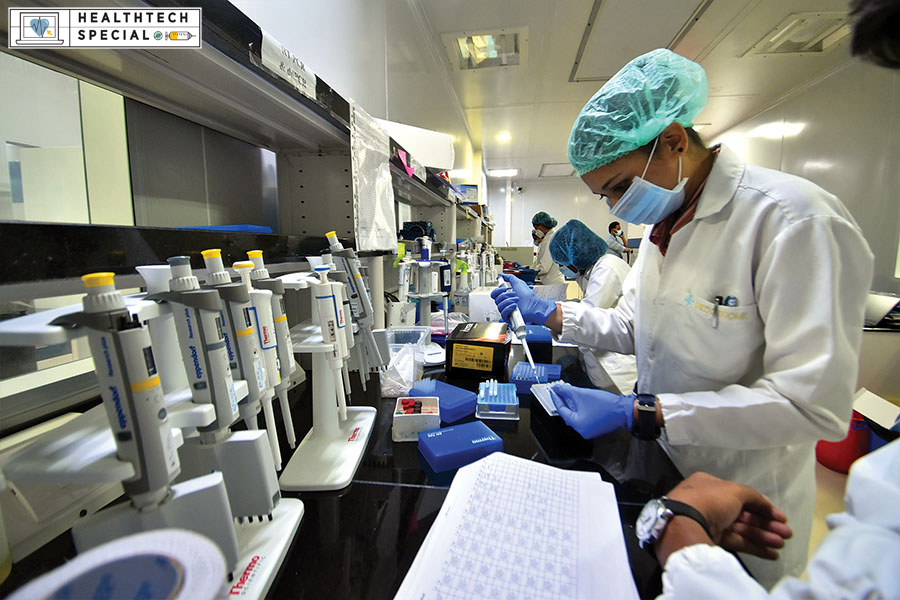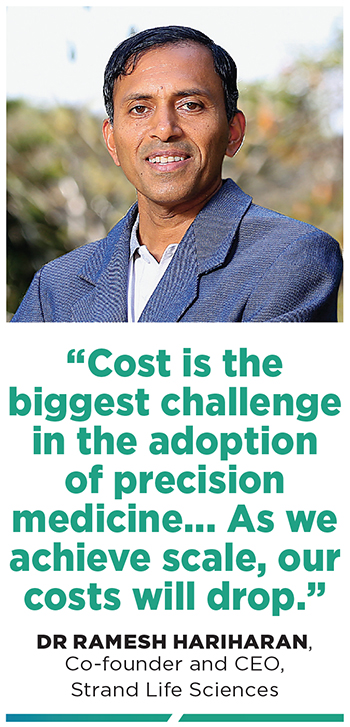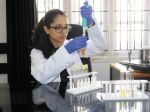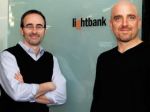
Inside the world of DNA decoding in India
Even as genetic-sequencing technology becomes cheaper and faster, the adoption of precision medicine, which decodes a patient's DNA to treat them in a more personalised, targeted way, remains limited in India. What will it take to turn it into an everyday reality?
 Scientists working on genome sequencing at the MedGenome lab in Bengaluru
Scientists working on genome sequencing at the MedGenome lab in Bengaluru
Image: Himadri Sharma for Forbes India
By the time Devina Bose, 65, noticed a lump in her breast, the tumour had advanced to stage four. Tests revealed that the cancerous cells were hormone receptor positive, which means they needed estrogen and progesterone to grow and spread, but HER2 negative, referring to a growth-promoting protein found on breast cells.
She was immediately put on hormone therapy drugs to lower her female hormone levels and make them less available to the growing cancer cells. Bose, a high court judge whose name has been changed, responded well to the treatment, says Dr Pramod Kumar Julka, director of oncology at Max Hospital in Delhi and former dean of AIIMS.
If not for genomic sequencing which is the key to precision medicine or idea of treating patients in a more personalised, targeted way, Julka would have relied on the cookie-cutter approach of surgery, radiation, and a blast chemotherapy to rein in Bose’s cancer. “No two patients with the same stage of disease respond to the same treatment,” says Julka. “Precision medicine is not the future, it is the present.”
Ever since the first human genome was sequenced in 2003—taking 13 years, hundreds of scientists and costing almost $3 billion—doctors have been predicting an age of precision medicine. Back then, much of it was hype, given the costs and time involved in sequencing a single genome, that is reading every one of the three billion letters of genetic information contained within the DNA in every cell of the human body. Over the years, the technology has become faster and cheaper—a genome can now be sequenced for $1,000 in a single day—yet the practice of precision medicine is yet to take off in the manner predicted.
 “Cost is the biggest challenge in the adoption of precision medicine,” says Dr Ramesh Hariharan, co-founder and CEO of Strand Life Sciences, a Bengaluru-based company that sequences genomes. Unlike the US where insurance companies cover health care costs, patients bear out-of-pocket expenses in India. That explains why genomic testing has become a routine, standard of care in the US for cancer patients, whereas in India, patients like Bose have to shell out vast sums—₹6 lakh in her case—for similar tests.
“Cost is the biggest challenge in the adoption of precision medicine,” says Dr Ramesh Hariharan, co-founder and CEO of Strand Life Sciences, a Bengaluru-based company that sequences genomes. Unlike the US where insurance companies cover health care costs, patients bear out-of-pocket expenses in India. That explains why genomic testing has become a routine, standard of care in the US for cancer patients, whereas in India, patients like Bose have to shell out vast sums—₹6 lakh in her case—for similar tests. In fact, rarely do doctors require a patient’s whole genome to be sequenced. Usually “panel sequencing” is performed where a few hundred genes relevant to the patient’s ailment—as opposed to all 20,000 present in the human body—are examined for abnormalities. For example, in the case of a neurological disorder, a doctor can request for panel comprising a few hundred genes and gain valuable insights. Companies like Strand or MedGenome—leaders in the space in India—carry out for anywhere between $200 and $400. In the US, while base tests would cost a similar amount, overheads such as costs connected with the interpretation and analysis of the data generated and genetic counselling can take the total up to $3,000, says Hariharan. “No one can afford that in India, so we don’t charge for overheads. That enables more patients to opt for sequencing. As we achieve scale, our costs will drop,” says Hariharan.
But waiting to achieve scale before prices fall is a chicken and egg situation. Costs must first fall for patients to opt for reading their DNA, but only if more people opt for the latter will prices fall. “The lowest hanging fruit is the cost of reagents that go into genome sequencing machines,” says Hariharan. They help to process the DNA and are currently imported from the US. But import duties are as high as 50 to 55 percent, says Hariharan. If that’s rationalised, costs would come down considerably.
Needed: local sequencing
Besides, India lags behind in cataloguing local genomes; such reference databases form the very foundation of precision medicine. While the first human genome was sequenced in 2003, the first Indian genome was sequenced in 2008 by a team of scientists led by Dr Sridhar Sivasubbu and Dr Vinod Scaria at CSIR-Institute of Genomics and Integrative Biology (CSIR-IGIB) in Delhi. Once a patient’s genome is sequenced, the data generated needs to be compared to a healthy reference genome to look for any variants or mutations. At present, reference databases are skewed towards Caucasian populations. South Asian representation is a mere 10 percent, according to 2019 study by Sirugo et al.
While this does not matter in the case of monogenic disorders caused by a single gene, according to Hariharan, it does matter when identifying mutations in polygenic disorders caused by genetic and lifestyle factors. For monogenic disorders, companies like Strand Life Sciences and MedGenome draw on global datasets to find gene mutations as well as their in-house data compiled over the years.
“India represents 17 percent of the world’s population with extensive genetic diversity but is underrepresented in global sequencing datasets,” says Sivasubbu. Even efforts like the GenomeAsia100K study, a global effort to sequence the genomes of Asian people, included just 598 samples from India—mostly specific castes from the south.
“Population-specific genome sequencing of Indians can help in characterising variants associated with diseases, improving precision medicine outcomes,” explains Sivasubbu. This was the “impetus” for the ‘IndiGen’ programme which sequenced the whole-genomes of 1,029 healthy Indian individuals in 2019. The database is publicly available. In a parallel effort, the GenomeIndia Project, spearheaded by Vijayalaxmi Ravindranath, was launched in January 2020 and aims to carry out whole-genome sequencing for 10,000 Indians from various representative communities.
“ You can monitor data from smart devices and implants. We’re getting closer and closer to the human body to unlock real-time information.”
Dr Eng Lim Goh, Chief Technology Officer for Artificial Intelligence, Hewlett Packard Enterprise
But sequencing an individual’s genome is not the “ultimate aim”, says Scaria. Turning the reams of data generated by genome sequencing into “actionable results” is the end goal. This led Scaria to set up the Genomics for Understanding Rare Diseases India Alliance Network (GUaRDIAN) along with Sivasubbu. Over 300 clinicians across 80 health care centres in the country refer rare disease patients to the GUaRDIAN team who, in turn, sequence their genomes or exomes, followed by computational analysis to identify variants in the patients’ genes. If mutations are indeed found, the team works to develop low-cost diagnostic tools and therapies to help the patient. For example, a few years ago, the team was able to diagnose a rare mutation in the MLC1 gene connected with neurological and muscular growth. Six children from a family belonging to the Nalband community in Agra were crippled by frequent seizures, bamboo-thin limbs and bloated heads. Their condition worsened with every passing year, so much so that the parents petitioned the government to terminate their lives. Local newspapers carried news of the family’s predicament, which caught the attention of the CSIR-IGIB scientists. A doctor at AIIMS noted that the symptoms appeared to fit a rare class of genetic disorders called leukodystrophies. Whole exome sequencing revealed a variation in the MLC1 gene of all the affected children.
As a follow up for this, an additional 83 members of the community were screened. Out of these, 24 were found to be the carriers of the gene and nine were affected. In order to aid the community, a polymerase chain reaction (PCR)-based test for the mutation in MLC1 was developed by the GUaRDIAN consortium for carrier status determination and prenatal screening, at an affordable cost. “This is where you see the real impact of our work,” says Sivasubbu. Another initiative set up by CSIR-IGIB called Gomed or Genomics and other Omics Technologies for Enabling Medical Decision is equally impactful in the realm of rare genetic diseases. It is estimated that over 70 million Indians are affected by such diseases. “A lack of access to quality healthcare and the high costs associated with testing mean that proper diagnosis is often not arrived at for the majority of patients,” says Dr Mohammed Faruq, a scientist who leads the effort at Gomed. “Gomed was borne out of a service agenda…to provide genetic testing free of cost to patients. That patient data furthers our research agenda,” he says. So far over 14,000 genetic tests have been carried out, benefiting about 4,000 patients through a clinical network of over 25 major medical centres across the country.Often times this effort helps to discover new, as yet undiagnosed genetic disorders. For example when a seven-year-old girl suffering from severe short stature visited a hospital in New Delhi for treatment in 2020, the doctor in charge, suspecting a rare genetic disorder, referred her to Gomed. Exome genetic sequencing was carried out and a hitherto unidentified mutation was discovered, responsible for the shortening of the girl’s limbs. “We looked for similar cases across the world and found a person in Spain had the same symptoms. It was the first time in the world that such a genetic defect was reported,” says Faruq. The team is now in the process of studying the bone cells, generated from the patient’s stem cells, to understand the underlying defect. “We’re trying to see whether we can circumvent the problem by finding a substitute for that gene defect. We might not be able to help this patient, who is now 8 years old, but if we can detect this mutation early on in future patients, then we might be able to help them. Such are the possibilities of the work we do.”
Privacy worries
While “significant” progress has been made in using genomic sequencing to detect and treat various forms of cancer, for paediatric neurological disorders and rare genetic diseases, there are legal and regulatory hurdles that need to be overcome before precision medicine percolates to the grassroots, says Dr Vedam Ramprasad, CEO of MedGenome, a large player in the genomic sequencing space, based in Bengaluru. Since genetic tests reveal underlying conditions or the risk of developing those conditions later on, the information can be used to discriminate against individuals. Insurance companies may deny premiums; employers may choose not to hire them. The US has legal protections against such discrimination but India does not have substantial laws in this regard. “Until you have safeguards against such discrimination, precision medicine cannot truly be achieved,” he says.
Additionally, in the absence of data privacy laws in India, the onus is on companies to safeguard sensitive medical data. “We put it upon ourselves to comply with the EU’s GDPR and the US-based Hipaa data protection laws,” says Hitesh Goswami, founder and CEO of 4BaseCare, a Bengaluru-based startup that is developing curated panels to be used in sequencing cancerous tissues.
A genome analytics economy
Genomes are but one source of personal health data. There are several other sources such as information from medical tests, electronic health data like the kind collected by telemedicine companies since the onset of the pandemic and real-time data from wearables like smart watches. All of these sources combined can help doctors better tailor treatments to individual patients. “You can monitor data from smartphones, wearables like smart watches and even embedded devices like implants. So we’re getting closer and closer to the human body to unlock intimate, real-time information. This is all in addition to genome sequencing data,” says Dr Eng Lim Goh, chief technology officer for artificial intelligence at Hewlett Packard Enterprise. The rise of artificial intelligence and machine learning tools will help analyse these reams of data, adds Goh.
It helps that India has a strong IT sector, points out Praveen Gupta, managing director and founder of Premas Life Sciences, the Indian partner of US-based Illumina which makes state-of-the-art genome sequencing machines. “Pundits say that in the next five to six years, 15 percent of the world’s population will be whole genome sequenced. If it takes 100 GB of data for a genome sequence, for 1.5 billion people, 25 to 30 exabytes of data will be needed. To put that in perspective, the entire data content on YouTube, globally, is 0.8 exabytes. Imagine the kind of data generation and analytics possibilities.” People will be needed to make sense of this data. Says Gupta, “If we can train our manpower, we can be leaders in this industry. We didn’t invent computers, but we created the IT industry. In the same way, we haven’t invented genome sequencing but we can create a genome informatics economy.”
The possibilities are endless and the promise enormous. “Genome sequencing should become as routine an MRI,” says Sivasubbu. No one can pin down how long that will take, but the Covid-19 pandemic has thrust forward the agenda. Says Strand’s Hariharan, “It’s created a large amount of awareness about genome sequencing. Nothing could have built this in such a short span of time.”


















